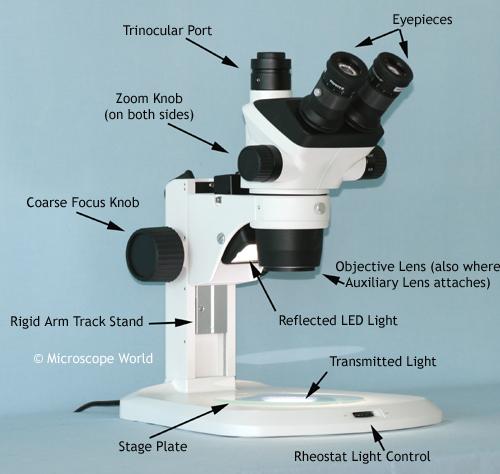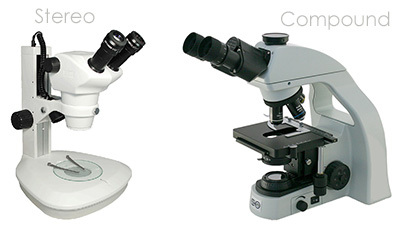What is a Stereo Microscope?
Sep 24th 2023
A stereo microscope, also known as a dissecting microscope, is a specialized optical instrument designed for three-dimensional viewing of objects at low magnification levels. Unlike compound microscopes, which use a single objective lens, a stereo microscope employs two separate optical paths, providing a binocular view. This enables users to perceive depth and details of solid objects, making it an invaluable tool in fields like biology, electronics, geology, and precision manufacturing. With its versatile applications, a stereo microscope is essential for tasks that require accurate, up-close examination in a three-dimensional context.
Parts of a Stereo Microscope
When it comes to the anatomy of a stereo microscope, understanding its various parts is crucial for harnessing its full potential. Let's delve into the key components that make up this powerful tool:

Eyepieces
The eyepieces, or ocular lenses, are where you peer through to view the magnified specimen. They play a pivotal role in determining the overall magnification.
Trinocular Port
This feature allows for the attachment of a camera or other imaging device, enabling you to capture and document your observations.
Zoom Knob (on both sides)
The zoom knobs offer precise control over the magnification level, allowing you to smoothly adjust the focus and level of detail.
Coarse Focus Knob
The coarse focus knob is used to make rapid adjustments in focus, particularly when first bringing the specimen into view.
Rigid Arm Track Stand
This stable and adjustable stand forms the foundation of the microscope, providing support and enabling precise positioning.
Stage Plate
The stage plate serves as the platform for placing specimens. It often features clips or holders to secure the specimen in place.
Rheostat Light Control
This control regulates the intensity of the illumination, allowing you to adjust the lighting conditions for optimal visibility.
Transmitted Light
Transmitted light is directed upwards through the specimen, making it ideal for transparent or translucent samples.
Reflected LED Light
This illuminates the specimen from above, making it particularly useful for opaque or reflective materials.
Objective Lens (also where auxiliary lens attaches)
The objective lens is a critical component responsible for the initial magnification. It's often paired with auxiliary lenses to further enhance the level of detail and magnification.
How Does a Stereo Microscopes Work?
A stereo microscope, also known as a dissecting microscope, offers a unique way of viewing objects in three dimensions. Unlike traditional microscopes, it utilizes two separate optical paths with corresponding objective lenses and eyepieces. This dual-optical system provides slightly different perspectives, which, when combined in the brain, result in a three-dimensional view of the specimen. This depth perception is crucial for tasks that require intricate examination of objects, making the stereo microscope an invaluable tool in various fields, including biology, electronics, and precision manufacturing. With the ability to adjust magnification levels, it offers flexibility and precision in observing objects of different sizes and complexities. By understanding the underlying principle of a stereo microscope, users can make the most of its capabilities for accurate and detailed examinations.

Stereo Microscope vs. Compound Microscope
When it comes to selecting the right microscope for your specific needs, understanding the differences between two commonly used types, the stereo microscope, and the compound microscope, is essential. The stereo microscope operates on a dual-optical system, utilizing two separate optical paths with distinct objective lenses and eyepieces. This design provides a three-dimensional view of the specimen, particularly suited for examining larger, solid objects with depth perception. In contrast, the compound microscope employs a single optical path, utilizing multiple objective lenses for higher magnification levels. It excels at studying smaller, transparent, or thinly sectioned specimens in great detail. Stereo microscopes typically offer lower magnification levels ranging from 5x to 50x, providing a broader field of view. They are favored for tasks like dissection, soldering, and circuit board inspection. On the other hand, compound microscopes specialize in higher magnifications, often ranging from 40x to 1000x or more, making them indispensable for the study of cells, bacteria, and tissues in biology and medicine. Ultimately, the choice between a stereo and compound microscope hinges on the nature of your specimen and the level of detail required for your specific field of study or application. Understanding their individual strengths empowers you to select the optimal tool for your microscopy endeavors.
What are Stereo Microscopes Used For?
Stereo microscopes are versatile instruments with a wide range of applications across various fields. Their unique optical design, providing a three-dimensional view of objects, makes them invaluable for tasks that require detailed examination of solid specimens. In the realm of biology, stereo microscopes are essential for tasks like dissection and intricate examination of organisms, allowing scientists to study anatomical structures with precision. In electronics and precision manufacturing, they play a critical role in tasks such as soldering, circuit board inspection, and quality control, where fine details and depth perception are crucial. Additionally, they find extensive use in geology and paleontology for the study of rocks, minerals, fossils, and other geological specimens. Their adaptability and ability to provide a clear, detailed view of objects in three dimensions make stereo microscopes an indispensable tool in a wide array of scientific and industrial applications. Whether in research, education, or industry, the stereo microscope stands as a cornerstone instrument for professionals and enthusiasts alike.




